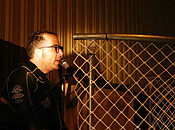2005
 Height of Man: 40 feet, standing (and rotating) upon a 32-foot tall Funhouse containing an interactive maze.
Height of Man: 40 feet, standing (and rotating) upon a 32-foot tall Funhouse containing an interactive maze.
Location: Black Rock Desert
Participants: Saturday: 35,567
Theme: Psyche – The Conscious, Subconscious & Unconscious.
- Great weather, more art and smooth operations combined to create what many dubbed “The best Burning Man yet.”
- The San Francisco Chronicle created “Burning Man At 20” – a feature series commemorating the twentieth burn. During the months leading up to the event, the paper published a series of articles about all things Burning Man.
- The Funhouse, the most intricate complex Man-base to date, was completed ahead of schedule. The structure contained a maze with 41 rooms – each with a different work of theme-related art. Participants who found their way through the maze could climb to the second level and rotate the Man.
- The Burning Man Project increased funding for art projects to support 32 artists. In total, 275 art projects took their places on the playa.
- A group of Burning Man participants calling themselves “BORG2” made a public challenge of the Burning Man Project to an “art duel” with a bet that BORG2 would raise $250,000 for art. BORG2 raised only $25,000, Chicken John ended up in a dunk tank at SF Decompression.
- A team of staff and volunteers from multiple departments redesigned the layout of Black Rock City. The new layout distributed Theme Camps radially into the city reducing the separation between the esplanade and streets farther back in the city.
- Theme camp registration processed 508 applications, and 485 theme camps were placed in Black Rock City.
- The Department of Mutant Vehicles registered 455 mobile artworks, including 297 daytime vehicles, 33 nighttime-only vehicles, and 125 that roved the playa both day and night.
- Black Rock City’s FAA-approved airport landed 92 planes with no problems or accidents.
- The Regional Contacts program grew to 80 regional groups worldwide, with an additional 35 interested applicants pending. The Regional Information Center was in Center Camp for the second year in a row. Burning Man hosted a regional summit in First Camp during the event.
- The Bureau of Land Management (BLM) developed a more stringent cleanup standard and inspection protocol for all permitted events within the Black Rock-High Rock National Conservation Area. The standard allows no more than 1 square foot of debris per acre. Burning Man passed the inspection on October 4, 2005. In 15 years of site inspections and monitoring, the BLM has discovered no significant long-term environmental effects caused by the Burning Man event.
- A delegation of board members traveled to Washington, D.C., for the third year in a row to meet with legislators and BLM officials. This year, the delegation also met officials from the Department of the Interior, who oversee all BLM operations.
- Embodying the principles of community, a group of dedicated participants, volunteers, and Burning Man staff organized their own independent relief effort on playa for the victims of hurricane Katrina. The efforts continued after the event ended and included raising and donating funds, entertaining refugees, and rebuilding communities. A crew from the Department of Public Works (DPW), Rangers, and temple crew volunteers set up operations in Biloxi. Calling themselves “Burners Without Borders,” they worked to rebuild a Buddhist temple destroyed by the hurricane.
- A new version of the “plone”-based Burning Man extranet was rolled out with improved features enabling staff and volunteers to communicate and share files from anywhere on the globe.
- Participants created PlayaNET, a public WiFi system covering all of Black Rock City.

